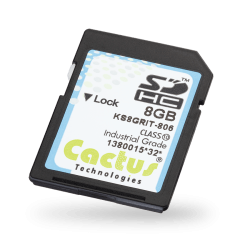Why SLC SD cards are Critical to Industrial Systems
 SLC SD cards were introduced with the SD Card specification in 1999 by the SD Association. In fact, many of the cards at that time were made exclusively with SLC NAND since that was the predominant memory at the time.Over the years, memory used in mainstream SD Cards has gone through two major changes.
SLC SD cards were introduced with the SD Card specification in 1999 by the SD Association. In fact, many of the cards at that time were made exclusively with SLC NAND since that was the predominant memory at the time.Over the years, memory used in mainstream SD Cards has gone through two major changes.
First, the trace width of NAND components has been reduced by several geometries. Each shrink lowers the NAND flash cell’s ability to handle endurance cycles. The finer the trace width, the less material in the oxide layer of the cell which is exhausted with every erase cycle.
The geometry shrink alone causes significant issues to reliability, but the second factor of adding additional bits per cell compounds the issue. Moving from SLC NAND (1 bit per cell) to MLC (2 bits per cell) to TLC (3 bits per cell)requires each cell to have multiple thresholds (states) which must be written and read precisely.
| NAND MEMORY TYPE | BITS PER CELL | NUMBER OF THRESHOLDS |
|---|---|---|
| SLC NAND | 1 | 2 |
| MLC NAND | 2 | 4 |
| TLC NAND | 3 | 8 |
What’s in your SD Card?
For consumer devices such as Cell Phones, Digital Cameras, Video Cameras and the like, the reduction of NAND geometry and additional bits per cell offer a great way to meet price points needed to enable new markets and applications.
On the other hand, Industrial Applications which originally used the SLC SD Cards have in many cases transitioned to the MLC or TLC NAND without the knowledge of the design engineer. Designers of many legacy systems have moved on to other projects or companies.
Support for these systems falls in the hands of sustaining engineers with too much on their plate or even to procurement groups which are not familiar with the intricacies of the NAND flash used in SD Cards.
Upon first use, when SD Cards based on any of the 3 types of NAND are fresh, there is not an issue with endurance cycles. If a short qualification is run, none of the cards will fail. Where the issue shows itself is during longer qualifications and during field usage. Over time endurance cycles of the TLC and MLC NAND SD Cards is exhausted and failures occur. Not a great scenario.
So What Can an OEM Do?

-
Analyze the number of endurance cycles required by your application
-
Thoroughly Qualify using accelerated test to replicate your actual usage model
The first item I suggest is to analyze the number of endurance cycles required by your application.
By calculating the number of endurance cycles used during a day, week or month and extrapolating out to the life of your program, you can determine what your SD Card capabilities must be. As always, adding a percentage to cover unexpected items is recommended.
Then, a thorough qualification using an accelerated test to replicate your actual usage model of years or more can provide the certainty of flash card selection.
What Can Cactus Technologies Do to Help?
For over 10 years, Cactus Technologies has been supporting OEMs Worldwide with the highest reliability Industrial Embedded Flash Storage Products using industry leading controller technology and industrial strength SLC NAND flash memory.
Our Industrial products enable OEM’s systems to operate without a fault in the harshest and most mission critical environments. In addition, Cactus offers Industrial MLC embedded products based on MLC NAND, which have Locked-BOM and Extended Life Cycles for budget limited applications not requiring extremely high endurance cycles.
If you’re an OEM designing an embedded system and have specific questions, please contact us for more information.






